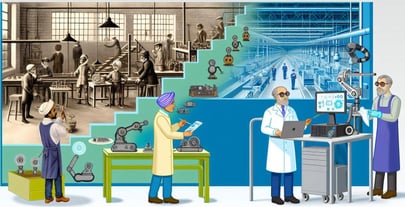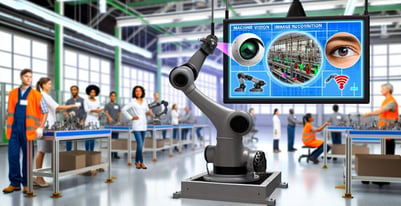Machine Vision and Image Recognition for Quality Inspection
Every product that leaves the production line must meet stringent standards to ensure customer satisfaction, uphold brand reputation, and adhere to regulatory requirements. Traditionally, quality inspection has been a manual and time-consuming process, often prone to human error. However, with advancements in technology, particularly in the fields of machine vision and image recognition, manufacturers now have powerful tools at their disposal to streamline and enhance quality inspection processes.
In this blog, we will explore the application of machine vision and image recognition in quality inspection within industrial manufacturing facilities. Furthermore, we will discuss the integration of these technologies with enterprise resource planning (ERP), supply chain management (SCM), and manufacturing execution systems (MES), particularly focusing on the integration between PlanetTogether and leading ERP systems such as SAP, Oracle, Microsoft, Kinaxis, and Aveva.

The Evolution of Quality Inspection
Quality inspection is not a novel concept in manufacturing. For decades, inspectors have visually examined products for defects, deviations, and inconsistencies. However, this manual approach is not without its limitations. Human inspectors can suffer from fatigue, subjectivity, and inconsistency in judgment, leading to potential oversights and errors. Moreover, as production volumes increase, manual inspection becomes increasingly impractical and inefficient.
The emergence of machine vision and image recognition technologies has revolutionized quality inspection processes. Machine vision systems leverage cameras, sensors, and algorithms to capture and analyze visual information from production lines in real-time. Image recognition algorithms can then identify defects, anomalies, or quality issues with a high degree of accuracy and precision, often surpassing human capabilities.

Advantages of Machine Vision and Image Recognition
Precision and Accuracy
Machine vision systems offer unparalleled precision and accuracy in quality inspection. By employing advanced algorithms, these systems can detect minute defects or variations that may elude human inspectors. This ensures that only products meeting the strictest quality standards proceed down the production line, minimizing the risk of defective or substandard items reaching consumers.
Speed and Efficiency
Unlike manual inspection, which can be slow and labor-intensive, machine vision systems operate at high speeds, capable of inspecting thousands of products per minute without compromising accuracy. This rapid inspection rate enhances production efficiency, reduces cycle times, and enables manufacturers to meet demanding production targets without sacrificing quality.
Consistency and Reliability
Machine vision systems provide consistent and reliable results, eliminating the variability inherent in human inspection processes. Once configured and calibrated, these systems perform inspections with unwavering consistency, ensuring that every product undergoes the same rigorous scrutiny. This consistency is essential for maintaining quality standards and regulatory compliance across all batches of manufactured goods.
Data-driven Insights
Beyond defect detection, machine vision systems generate vast amounts of data regarding production quality and performance. By leveraging this data through advanced analytics and reporting tools, manufacturers gain valuable insights into process optimization, defect root cause analysis, and predictive maintenance. These data-driven insights empower informed decision-making and drive continuous improvement initiatives throughout the manufacturing operation.


Integration with ERP, SCM, and MES Systems
While machine vision and image recognition technologies offer tremendous benefits in quality inspection, their true potential is unlocked when seamlessly integrated with enterprise-level systems such as ERP, SCM, and MES. Integration enables real-time data exchange, synchronization of workflows, and holistic visibility across the entire manufacturing ecosystem. Let's look into the integration between machine vision/image recognition systems and leading ERP platforms such as SAP, Oracle, Microsoft, Kinaxis, and Aveva, with a focus on the integration with PlanetTogether.
Integration Benefits
Streamlined Operations: Integration between machine vision systems and ERP/SCM/MES platforms streamlines operations by automating data transfer and eliminating manual intervention. This ensures that quality inspection results are seamlessly integrated into production schedules, inventory management systems, and order fulfillment processes.
Enhanced Traceability: By linking quality inspection data with ERP/MES systems, manufacturers achieve enhanced traceability throughout the production lifecycle. Every product can be traced back to its origin, enabling swift identification and containment of quality issues. This level of traceability is particularly crucial in industries with stringent regulatory requirements, such as pharmaceuticals and aerospace.
Optimized Resource Allocation: Integration enables real-time visibility into production quality and performance metrics, allowing manufacturers to optimize resource allocation and prioritize tasks accordingly. For instance, if a quality issue is detected during inspection, production schedules can be dynamically adjusted, raw materials can be quarantined, and corrective actions can be initiated promptly.
Data-driven Decision Making: By consolidating data from machine vision systems with ERP/MES platforms, manufacturers gain a comprehensive understanding of their operations. This data-driven approach enables proactive decision-making, predictive maintenance, and continuous process improvement, driving operational excellence and competitive advantage.

Integration with PlanetTogether
PlanetTogether is a leading production planning and scheduling software that enables manufacturers to optimize their production processes, improve efficiency, and meet customer demands. By integrating machine vision and image recognition technologies with PlanetTogether, manufacturers can achieve seamless synchronization between quality inspection results and production schedules.
Key Integration Features
Real-time Data Exchange: Quality inspection results are transmitted in real-time to PlanetTogether, allowing production schedules to be adjusted instantaneously based on inspection outcomes.
Dynamic Scheduling: Upon detecting defects or quality issues, PlanetTogether dynamically adjusts production schedules to prioritize rework, allocate resources, and minimize production disruptions.
Quality-driven Planning: Quality inspection data serves as input for predictive analytics within PlanetTogether, enabling proactive planning and optimization of production processes to prevent quality issues before they occur.
Continuous Improvement: Integration with PlanetTogether facilitates continuous improvement initiatives by providing actionable insights into production quality, enabling manufacturers to refine processes, implement corrective actions, and drive operational excellence.
The application of machine vision and image recognition for quality inspection represents a transformative advancement in industrial manufacturing. By leveraging these technologies, manufacturers can enhance product quality, improve efficiency, and drive competitive advantage in today's dynamic marketplace. Furthermore, by integrating machine vision systems with ERP, SCM, and MES platforms such as PlanetTogether, manufacturers can unlock synergies, streamline operations, and achieve unprecedented levels of productivity and performance.
As manufacturing landscapes continue to evolve, embracing innovation and leveraging cutting-edge technologies will be critical for staying ahead of the curve. Are you ready to take your manufacturing operations to the next level? Contact us today to learn more about how PlanetTogether can help you achieve your goals and drive success in your industry.



